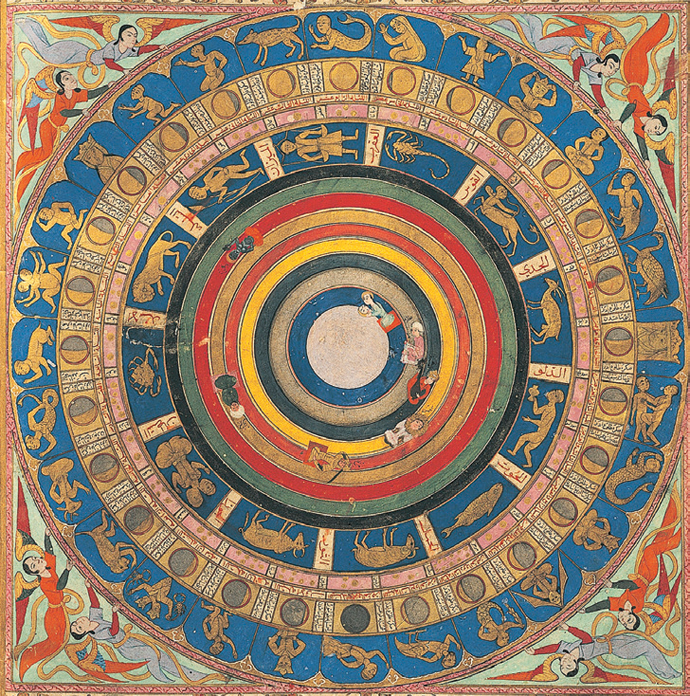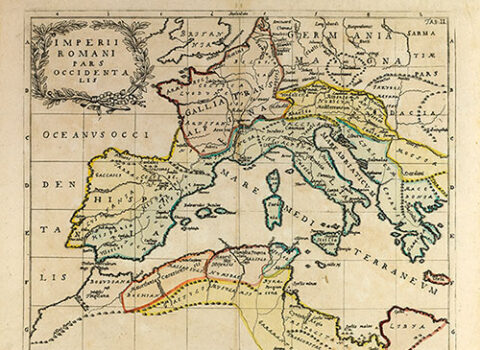Discussed in this essay:
Where Reasons End, by Yiyun Li. Random House. 192 pages. $25.
The End of the Myth: From the Frontier to the Border Wall in the Mind of America, by Greg Grandin. Metropolitan Books. 384 pages. $30.
Time and Its Adversaries in the Seleucid Empire, by Paul Kosmin. Harvard University Press. 392 pages. $55.
Ten years ago, a week after his sixtieth birthday, and six months after his first appointment with an oncologist, my father died. That afternoon, I went to my parents’ bedroom to clear up the remains of the lunch my mother had brought him not long before he collapsed. A copy of Yiyun Li’s novel The Vagrants, which he’d asked me for after I reviewed it in a newspaper, was open on his bedside table. He had gotten about halfway through it. The Vagrants isn’t what you’d call a consoling book—it centers on a young woman’s unjust execution in a provincial Chinese town in 1979—and I had mixed feelings about it being the last thing he’d read. Perhaps an adolescent part of me had been happy to let him have it out of a need to see him as a more fearless reader than he might have wanted to be just then. Still, my father had read Proust and Robert Musil while working as a real estate agent. There was comfort, of a sort, for me, and maybe him, in his refusal of comfort reading.

“Christmas Tree,” by Debbie Fleming Caffery © The artist. Courtesy Octavia Art Gallery, New Orleans
At that time, I had been reading, for weeks, Dostoevsky’s Demons, also known as The Possessed. When I finished it, a few days after the funeral, I wasn’t ready to leave the strange bubble of time—of which the book had become a part—in which my family seemed to be suspended. I started reading The Master of Petersburg by J. M. Coetzee, a novel reimagining some of the events that provoked Dostoevsky into starting work on Demons. It’s one of the books that cemented Coetzee’s reputation as a cold, professorial writer. But it isn’t really a cold book. Writing about Russia in the 1860s seems to have been, in part, Coetzee’s way of getting at something he couldn’t approach more directly: his son Nicolas’s death, in 1989, at the age of twenty-two—a death the novel transfers, unhistorically, to Dostoevsky’s stepson. The road might lead through “harsh, stunted country,” as the critic Michael Wood once wrote of Coetzee’s fiction, but it “arrives at a region of desperate feeling.”
Yiyun Li is now reporting from a similar region, and I’ve mentioned these bookish ways of keeping loss and grief at a distance, while at the same time bringing them close, because that’s how she goes at things in Where Reasons End (Random House, $25), a novel concerned with the death of a child. A beautifully written book that runs a quizzical eye over the urge to deal with sorrow by writing beautiful sentences, it’s closer to the essays gathered in Dear Friend, from My Life I Write to You in Your Life—which deal, by way of Li’s interest in certain Russian and Irish writers, with an experience of suicidal depression—than it is to her more self-effacing novels and short stories. Its narrator, a Chinese-born American writer, is a version of Li herself, and the book consists of sixteen imagined conversations between her and her son, Nikolai (“not his real name”), who, it’s made clear, has recently killed himself at the age of sixteen. A dedication indicates that Li is writing “in memory of Vincent Kean Li (2001–2017).”
Nikolai emerges in vivid fragments: his love of bad weather and baking, the Diary of a Wimpy Kid T-shirt he wore as a pajama top, his precocious—“I had flinched whenever people called him precocious”—cleverness. More obliquely, we hear of agitation, unappeasable perfectionism, and fourth-grade teachers alarmed by his written work’s “inconsolable bleakness.” There are passing snapshots of the narrator’s new life: a house move, a change of season. But the book is chiefly concerned with dramatizing the back-and-forth of the narrator’s thoughts in a fictive space in which she “had made time irrelevant.” Some of the writing is sharply aphoristic, and there are some hair-raising sentences. The narrator feels unable to buy a new plastic Christmas tree: “The life of an artificial tree is devastatingly long.” At the same time, she imagines Nikolai turning her store of writing-school wisdom against her. Emotive reflections on his funeral elicit from him a teacherly “Yikes. . . . Sounds like a bad sentence from a sentimental biography.”
Then there are the big questions. “For years he had asked me: If you write about suffering, if you understand suffering, why did you give me a life? I had never given him an answer good enough.” Her own experience of psychic distress means that she’s “benumbed yet un-astonished” by his suicide: “Calling Nikolai’s action inexplicable was like calling a migrant bird ending on a new continent lost. Who can say the vagrant doesn’t have a reason to change the course of its flight?” Some readers, she knows, will interpret these dialogues as symptoms of “insanity or religiosity,” not as high-wire acts performed over an unimaginable drop. The tone is hushed, domestic, affectionate, with no Dostoevskian scenery-chewing or Tolstoyan efforts to nail down the meaning of life. All the same, you get a sense—as one of Coetzee’s characters says of the Russian masters—of being brought to a “battle pitched on the highest ground.”

“El bordo/The Border,” by Antonio Turok © The artist. Courtesy The Wittliff Collections, Texas State University, San Marcos
A feeling of numbed reenactment, and even a collapse of a sense of time, can also be a result of more collective disturbances. In his history of America’s changing conception of its borders, The End of the Myth: From the Frontier to the Border Wall in the Mind of America (Metropolitan Books, $30), Greg Grandin writes that at the southern US border today, “all of history’s wars become one war.” Veterans of Afghanistan and Iraq—some of them anti-immigrant vigilantes, others employees of the federal government—watch for phantom armies of “Middle Eastern guys with beards,” or picture themselves as “the rear guard of the Mexican–American War of 1846–48.” Suggestive parallels are everywhere. The “first significant physical barrier” to go up along the border—4,500 feet of chain-link fencing, erected near Calexico, California, in 1945—was recycled, Grandin says, from a wartime camp in which Japanese Americans and others were interned. In Otay Mesa, east of San Diego, eight prototype sections of Trump’s promised wall look to Grandin like tombstones for the idea of the frontier as the site of the nation’s “perennial rebirth.”
How did we get, in the words of Grandin’s subtitle, from the frontier to the border wall? Over the eighteenth and nineteenth centuries, it became a commonplace that a uniquely American political culture of democratic, pragmatic, forward-looking individualism had been fostered by proximity to the wilderness. In 1893, a previously obscure historian, Frederick Jackson Turner, repackaged this idea for the Progressive Era in “The Significance of the Frontier in American History,” an essay that, as Grandin notes, later generations of Americanists would cite “the way monks chant a creed.” Turner launched the frontier into pure abstraction. The frontier experience, he taught, would lead to a progressive universalism. Material progress would soon make notions of race and class seem like relics of more primitive times. Franklin Roosevelt was a student of Turner’s at Harvard, and lofty Turnerian rhetoric helped promote the New Deal as well as Kennedy’s Cold War liberalism. What could be more different from a Republican presidency animated by fear, greed, suspicion of democracy, and an obsession with walling up the old frontier?
Grandin’s history of the frontier “in the mind of America” unravels Turner’s thesis—with due acknowledgment of its poetic qualities—and puts Trump’s white supremacy in a longer perspective. “Frontiersman” is another way of saying “white settler,” and nineteenth-century theorists of the frontier weren’t always squeamish about the racialized violence that accompanied westward expansion. Theodore Roosevelt, for one, celebrated it in print, rebuking “sentimentalists” for fretting over the extermination of Native Americans. Like Woodrow Wilson, he also subscribed to the view that American political institutions were a racial inheritance from pre-feudal Germanic freemen. Turner had no time for any of that: a big part of his appeal, in his day, was that he seemed to put the whole enterprise on a more sober footing. To do that, he made only passing reference to “a series of Indian wars.” (During Turner’s Wisconsin childhood, his father had lobbied, successfully, for the forced removal of Winnebago and Menominee villagers.) “The slavery question,” too, was a minor matter.
As a corrective, Grandin’s book balloons into a short history of the United States, with an emphasis on the racial terror, official and unofficial, that marked the story from the start. As he sees things, the hardy frontiersmen—or “overflowing Scum of the Empire,” as an eighteenth-century British governor put it—represented, among other things, a solution to the problem of surplus labor. Labor leaders didn’t want wages to collapse; landowners and industrialists feared unemployed malcontents. Opening up the frontier dealt with both worries. Grandin isn’t short of eye-popping evidence for the “blood-soaked entitlement” that underpinned all this, though he views it through a distinctively Trumpian lens. John Quincy Adams comes across as an Obama-like figure, reduced to watching Andrew Jackson, his racist, populist successor, “dismantle his political legacy.” The Reconstruction-era Freedmen’s Bureau is likened to Obamacare, and Grandin also writes about James Wilson, a Pennsylvanian who died, in 1798, on the run from his creditors while still a sitting Supreme Court justice—a fate that’s unlikely to catch up with the debt-free Justice Brett Kavanaugh.
When the story gets closer to the Fox News–addled present, more familiar characters rear up from unexpected angles. Joe Arpaio, the Maricopa County sheriff famous for mistreating Latino prisoners, and for being pardoned by Trump, makes an early appearance, in 1969, alongside one of the Watergate plumbers. Harlon Carter, a key figure in the NRA’s turn to hard-right extremism in the Seventies, first makes his mark, in 1931, by killing a Mexican teenager. Grandin—a gifted scholar and storyteller who’s best known as a Latin Americanist—writes powerfully about anti-immigrant nativism’s return from the margins as a “border-fication of national politics.” Elsewhere, he organizes his sprawling story around metaphors and symbols: the Confederate flag’s rehabilitation, when former Civil War enemies fought side by side for the first time during the invasion of Cuba in 1898; and the nineteenth century’s fixation on the newly invented safety valve as an image for the frontier. The connections here aren’t always as persuasive as they could be. Were Reagan’s wars in Central America really conceived as an outlet for domestic discontent in the same way that extending the frontier once was? That seems to push the safety valve metaphor quite far.

A map of the universe: the globe, the seven saints of the heavens, the zodiac, and the days of the month Miniature from Tales of Luqman, Arabic manuscript, 1583 © akg-images/De Agostini Picture Library/G. Dagli Orti
“Life,” Li’s narrator is fond of saying when she’s teaching writing classes, “is not lived by metaphors.” Paul Kosmin, a Harvard classicist with another story to tell concerning dispossession, repetition, and strange dislocations of time, would probably disagree. His new book, Time and Its Adversaries in the Seleucid Empire (Harvard University Press, $55), tells the story of how the Seleucid Empire revolutionized chronology by picking a Year One and counting from there, rather than starting a new count, as other states did, each time a new monarch was crowned.
The Seleucid Empire was founded in the fourth century bc by one of the Macedonian generals who carved up the territories that Alexander the Great had conquered. Early on, it ran all the way from what’s now Turkey to what’s now Pakistan, with a Greek-speaking aristocracy calling the shots from Babylon. The empire is mostly remembered for its role in the Hanukkah story: the Seleucids are the foreign overlords who triggered the Maccabean Revolt by trying to replace Jewish worship with alien Hellenistic practices, such as stripping naked and coating oneself with olive oil. (This habit caused comment among the Babylonians too.) “The Seleucid Era was the world’s first continuous tally of counted years,” Kosmin writes, “and the unheralded model for all subsequent era systems,” ours included. Like weights and measures, time was stamped with imperial authority. There might even have been a Temple of Day One.
Until the Seleucids came along, ancient dating systems, Kosmin explains, were a complicated business. Thucydides, writing in the fifth century bc, dated the outbreak of the Peloponnesian War, in what we’d call the spring of 431, like this:
The Thirty Years Treaty agreed after the conquest of Euboea lasted for fourteen years. In the fifteenth year, when Chrysis was in her forty-eighth year as priestess of Argos, Aenesias was ephor in Sparta, and Pythodorus had two more months of his archonship in Athens, in the sixth month after the battle of Potidae, and at the beginning of spring, in the first watch of the night an armed force of slightly over three hundred Thebans entered Plataea . . .
It’s very comprehensive scene setting, and, as Kosmin points out, it synchronizes the opening skirmish “to diplomatic, religious, civic, military, seasonal, and hourly data points.” But techniques of this sort weren’t particularly helpful if you were trying to file a tax return, or run an enormous transnational bureaucracy, which is where the Seleucids enter the picture.
So much for time. What about its adversaries? For subject populations, Kosmin suspects, the Seleucid Era sealed off the past and opened up a grim vista of bureaucratic time measurement, with no opportunities for starting over and no end in sight. Did this cause a “crisis of meaning regarding temporal duration”? Kosmin scours the written and material evidence for signs of conscious rebellion against the Seleucid temporal regime. Exhibit A is end-times literature, and in particular the Book of Daniel, in the Bible, in which the “feet of clay” in Nebuchadnezzar’s dream denote the Seleucid Empire. In Daniel, only God can be “the one who changes the times and the seasons,” and excavations in northern Israel—which show that an archive room was singled out for destruction during the sacking of a Seleucid administrative center—might suggest that the Maccabees put similar ideas into practice. From here on out the argument gets extremely conjectural, though lots of the material is fascinating either way. A fragmentary Babylonian “Dynastic Prophecy,” for instance, looks primordial and otherworldly until you reach the last line:
The people, who had [experienced] misfortune,
[Will enjoy] well-being
The heart of the land [will be happy]
Tax exemption . . .
It’s good to see an academic in a rarefied field put forward sweeping theories involving “a battle over the control of time and the architecture of history.” But the Seleucids’ breakthrough in forward-planning technology didn’t do their empire much good. Rival states chipped away at the empire’s vast territories from the start, dooming later Seleucid monarchs to hopeless second attempts of earlier military campaigns, and contemplation of what they’d lost. In the end, the Parthians and then the Romans took over. Seleucid Era years rolled on “like emptied jars,” lingering for a while—but only for a while—in “late antique Syrian mosaics, Yemenite Jewish marriage contracts, Arabic astronomy, Chinese Nestorian inscriptions, and so forth.” So the author (or authors) of the Book of Daniel might be said to have had the last laugh—except that he (or they) would have been equally horrified by the Christian-era count that eventually took over.









































































































